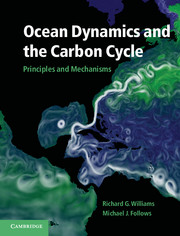Book contents
- Frontmatter
- Contents
- Preface
- Acknowledgements
- Illustration credits
- Part I Introduction
- Part II Fundamentals
- Part III Physical Phenomena and their Biogeochemical Signals
- Part IV Synthesis
- 13 Integral frameworks
- 14 Overview and further challenges
- Appendix
- Symbols and definitions
- Glossary
- Answers
- References
- Index
- Plate section
14 - Overview and further challenges
from Part IV - Synthesis
Published online by Cambridge University Press: 05 June 2012
- Frontmatter
- Contents
- Preface
- Acknowledgements
- Illustration credits
- Part I Introduction
- Part II Fundamentals
- Part III Physical Phenomena and their Biogeochemical Signals
- Part IV Synthesis
- 13 Integral frameworks
- 14 Overview and further challenges
- Appendix
- Symbols and definitions
- Glossary
- Answers
- References
- Index
- Plate section
Summary
At the simplest level, the role of the ocean on the Earth is relatively easy to understand. The ocean stores and redistributes heat, makes the atmosphere moist and the Earth's climate more equitable. The ocean contains dissolved nutrients and gases, and provides an environment for a vast diversity of living creatures. Phytoplankton grow in the sunlit, surface ocean, performing half of the photosynthesis over the globe, creating organic matter which sustains almost all of the living creatures in the sea. The ocean holds more than sixty times as much carbon as in the atmosphere due to the reactivity of carbon dioxide in seawater.
To gain a deeper understanding of the ocean, we must adopt a holistic approach and understand the interplay of physical, chemical and biological processes, as illustrated in Fig. 14.1a,b. Next we discuss these connections.
Interconnections between the physics, chemistry and biology
To develop a more complete view, we must first understand a set of fundamental concepts: how tracers are transported; how the ocean circulates in response to atmospheric forcing; how phytoplankton cells turn inorganic nutrients into organic matter; and how carbon dioxide reacts in seawater and is exchanged with the atmosphere. Drawing on these concepts, the interconnections within the ocean become much clearer; many of the physical phenomena leave a characteristic imprint on the distributions and cycles of nutrients and carbon, in turn affecting life in the ocean.
- Type
- Chapter
- Information
- Ocean Dynamics and the Carbon CyclePrinciples and Mechanisms, pp. 354 - 359Publisher: Cambridge University PressPrint publication year: 2011



